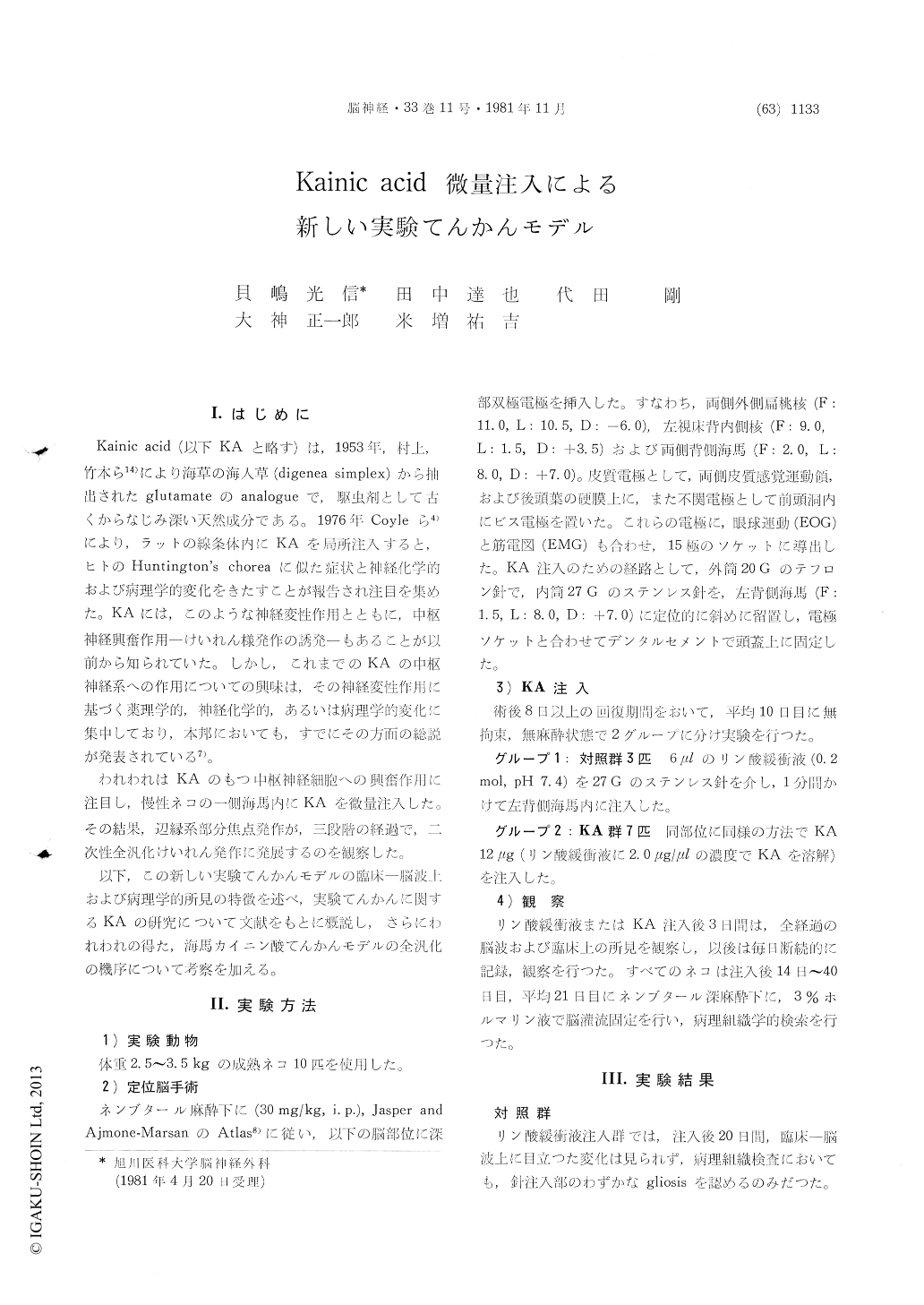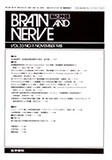Japanese
English
- 有料閲覧
- Abstract 文献概要
- 1ページ目 Look Inside
I.はじめに
Kainic acid (以下KAと略す)は,1953年,村上,竹本ら14)により海草の海人草(digenea simplex)から抽出されたglutamateのanalogueで,駆虫剤として古くからなじみ深い天然成分である。1976年Coyleら4)により,ラットの線条体内にKAを局所注入すると,ヒトのHuntington's choreaに似た症状と神経化学的および病理学的変化をきたすことが報告され注目を集めた。KAには,このような神経変性作用とともに,中枢神経興奮作用—けいれん様発作の誘発—もあることが以前から知られていた。しかし,これまでのKAの中枢神経系への作用についての興味は,その神経変性作用に基づく薬理学的,神経化学的,あるいは病理学的変化に集中しており,本邦においても,すでにその方面の総説が発表されている7)。
われわれはKAのもつ中枢神経細胞への興奮作用に注目し,慢性ネコの一側海馬内にKAを微量注入した。その結果,辺縁系部分焦点発作が,三段階の経過で,二次性全汎化けいれん発作に発展するのを観察した。
Kainic acid (KA) is a potent analogue of gluta-mate, of which two major effects, neurotoxic (neurodegenerative) and neuroexciting, have been generally accepted. In regard to the former effect, many studies have been reported including a model of Huntington's chorea which was produced by means of microinjection of KA into the striata ofrats. The latter effect is important in the produc-tion of experimental epilepsy. In 1979 Ben-Ari et al reported a new model of focal status epilepticus by intra-amygdaloid application of KA in rats. These two contradictory effects, neurodegenerative and neuroexciting, are explained as a serial changes of neurous to chemical action of KA, that is, KA interacts with glutamate receptor resulting in prolonged depolarization and this chronic excitation would lead to irreversible ionic imbalance resulting in cell death.
In this study, KA (12μg dissolved in 6μl pho-sphate buffer) was injected into unilateral hip-pocampus of chronic cats, and electrophysiological and clinical features were observed for 14 to 40 days. Phosphate buffer was injected into uni-lateral hippocampus in 3 cats and no eletrophysio-logical, clinical or pathological change was observed in these control study.
In KA group epileptic seizure started with limbic status and developed into generalized status. The course may be divided in 3 stages.
1) Limbic status stage
Immediately after injection of KA, focal multiple spiking discharges on EEG started in the injected hippocampus and propagated into bilateral limbic system with clinical manifestations of limbic seizure such as attention, immobility and couching. Clinically cats started to run around the opposite side of the injection and finally became unable to keep standing and lay down with continuing walking like movement in four limbs. Autonomic signs such as hypersalivation, mydriasis and hyperventilation were also observed. These limbic seizures continued for 2-3 days clinically as well as on EEG.
2) Transfer stage
Two to three days after injection, cats became free of seizures and restored thier activities, though sporadic and synchronous spikes were still observed in the limbic system. Thereafter a secondary epi-leptogenic focus developed on EEG in the ipsilateral amygdala followed by repeated amygdaloid seizures manifested with licking, chewing, head nodding and ipsilateral facial twitching. Day by day the amygdaloid seizure increased in frequency and intensity.
3) Generalized status stage
About 10 days after injection, a secondary gener-alized seizure started. Electroencephalographically the hippocampal spikes of the injected side trig-gered successive multiple spikes in the ipsilateral amygdala and other limbic structures and finally resulted in generalized convulsion. Clinically cats exhibited generalized status epilepticus and died of cachexia about 20 days after injection.
Histological study disclosed an extensive cell loss of pyramidal cell layer in the hippocampus of the injected side.
There are two characteristics in this new model of epilepsy. One is the prolonged epileptic dis-charges in the hippocampus of the injected side, which started immediately after injection and continued until death. Another feature is develop-ment of seizure in 3 stages from limbic stage to generalized status stage with an intermission; transfer stage.
The mechanism in the generalization of limbic status in our model is interesting in understanding a clinical generalization of focal epilepsy. We pos-tulate that the formation of the secondary epilep-togenic focus in the ipsilateral amygdala by per-sistent bonbardments on the spike discharges from the injected hippocampus plays an important role.
We conclude that this model of epilepsy is a good one to investigate a secondary epileptogenic focus and the process of generalization from limbic seizure.

Copyright © 1981, Igaku-Shoin Ltd. All rights reserved.


